Today we’ll take a look at the Crimson Trace laser grip for the Smith & Wesson J-Frame revolver. It is worth it and does it have merit? Read on, because it will get a full review here.
Specifications
The Crimson Trace LG-105 grips that I received are for the Smith & Wesson J-Frame revolver. They will fit the Airweight (I have the 642), Airlite, Bodyguard, Chiefs Special, Centennial, and Ladysmith. Round butts only. There are both red and green lasers available for this grip. The one I’m reviewing today is red.
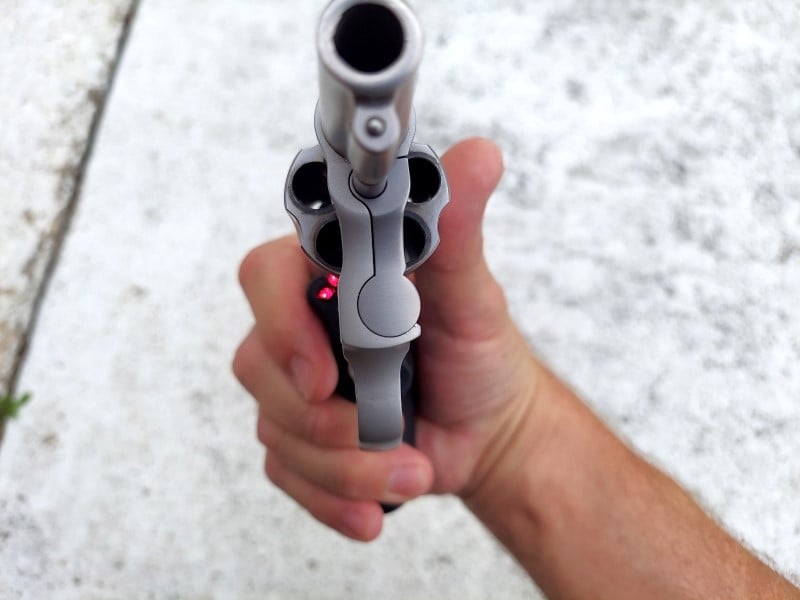
The red laser features a beam that is the strongest allowed by law; 5mW. The green laser (Model CMR-206) is a 5mW 515-532nm Class 3R.
As far as weight is concerned, there is no discernable difference between the factory grips and the Crimson Trace unit. If there is, it is negligible.
Batteries & Installation
The unit is powered by two 2032 batteries. The life of the batteries for the red laser is listed at four hours, and two hours for the green laser. The green laser uses one battery that is different from those that power the red laser. Note: I tested the red laser. I did not have a green unit to test. Speaking of batteries, Crimson Trace offers a “Free batteries for life” program. There is a procedure for this program by contacting the company.
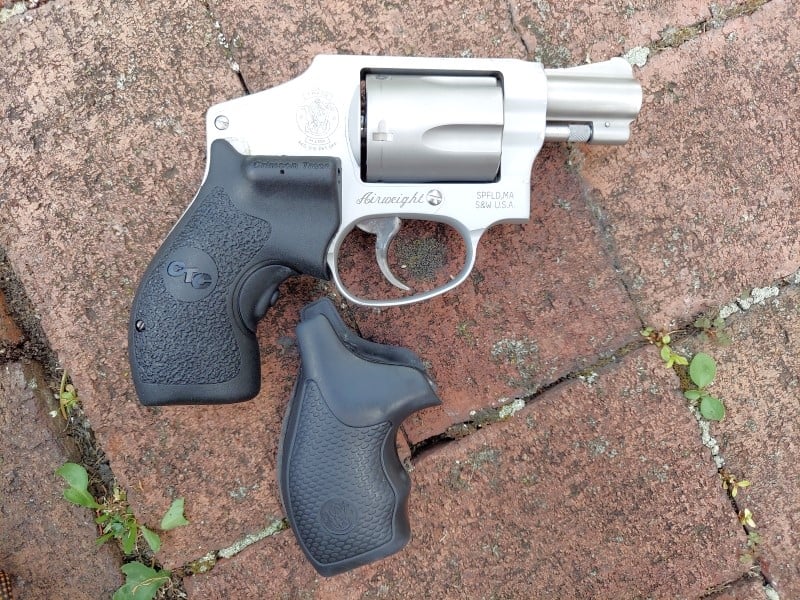
The batteries were fairly easy to install, and directions are provided. The grips come in two halves and, after the factory grips are removed, both halves of the Crimson Trace grips are simply brought together and screws inserted. That’s it, really. It took me about five minutes and is a simple, easy process.
Laser Grip
The polymer grip has a crinkle texture for a positive grip. The dimensions of the Crimson Trace grip appear to be exactly the same as the factory grips from S&W. The texture, however, feels different, in that the factory grips are slightly softer. They’re grippier and slightly “tacky.” I’m partial to the softer feel of the factory grips, they seem to offer a slightly better purchase in the hand.
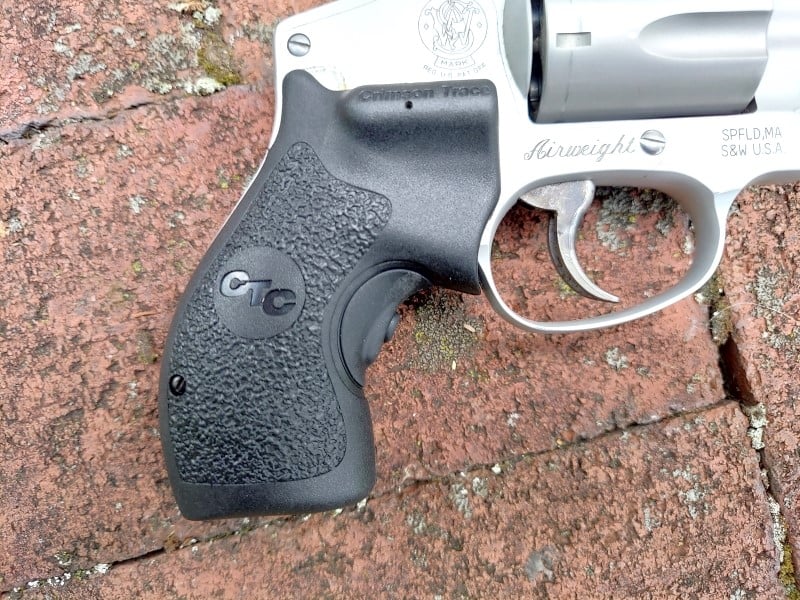
Neither the factory grips, nor these from Crimson Trace, will allow the easy use of a speed loader to load the revolver because they interfere with the angle that the loader needs to be held at. I wish both companies would take this into account and fix the issue. I’d really like the ability to recharge my revolver using speed loaders.
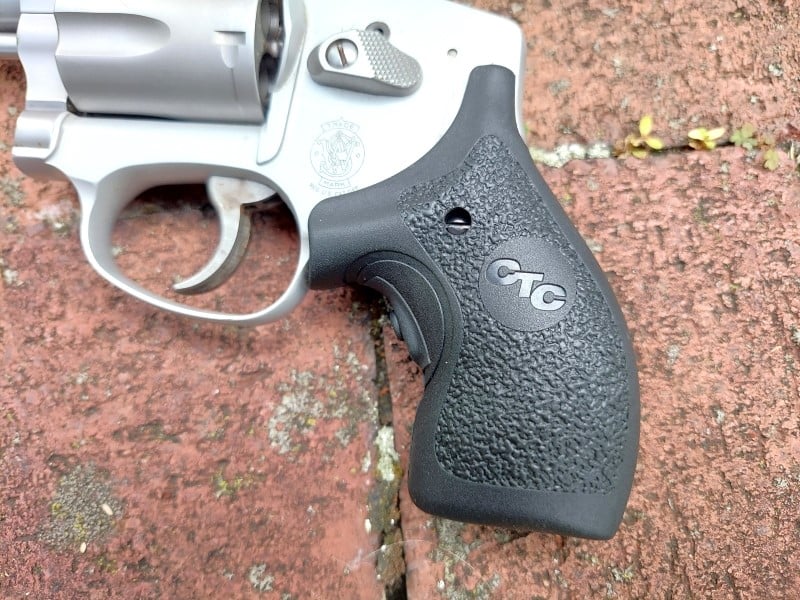
Beam Me Up
The beam is very intense and provides a dot approximately 1/2-inch in circumference at 50 feet. In bright sunlight, the beam is very difficult to see. This laser is mostly intended for use in dim light.
A green beam would likely be more visible in these conditions but would also be hard to discern.


Maintenance
Crimson Trace advises that the laser needs minimal maintenance. Occasional cleaning of the lens is recommended using the supplied Q-tip-like things (although regular Q-tips will suffice as well). They caution against using certain cleaning solutions on the grips and list the prohibited ones in the accompanying manual.
Adjustments
It’s easy to adjust the laser so that it is zeroed at the range. Basically, you adjust it so that the beam is sitting on the top of your front sight post, where you’d normally expect the bullet to hit. Figure out the range where you want the gun to be zeroed, and adjust the beam to the sights so they co-witness.

There are two adjustment screws that are very, very tiny. A small Allen wrench is included and is inserted into small holes on the right side of the laser. The top one adjusts the elevation, and the side one is for windage. A very small adjustment moves the impact a good amount, so it’s not necessary to be cranking down on the adjustments.
Activation
The activation button for this particular unit is on the front of the grip. As such, when you grab the grip, the laser comes on. I see this as both a good and bad thing.
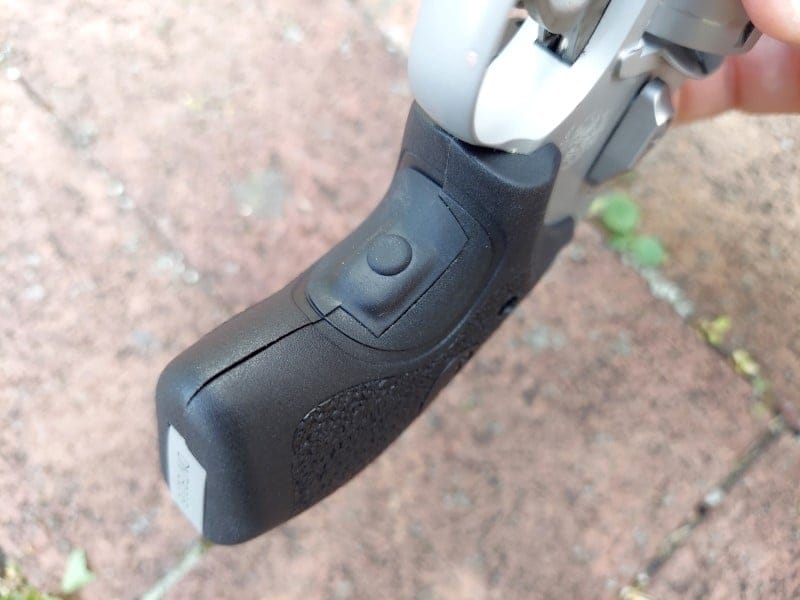
It’s good, in that you don’t have to think about it. There’s nothing to forget under stress, it’s automatic. One less thing to forget to do when the stuff is hitting the fan.
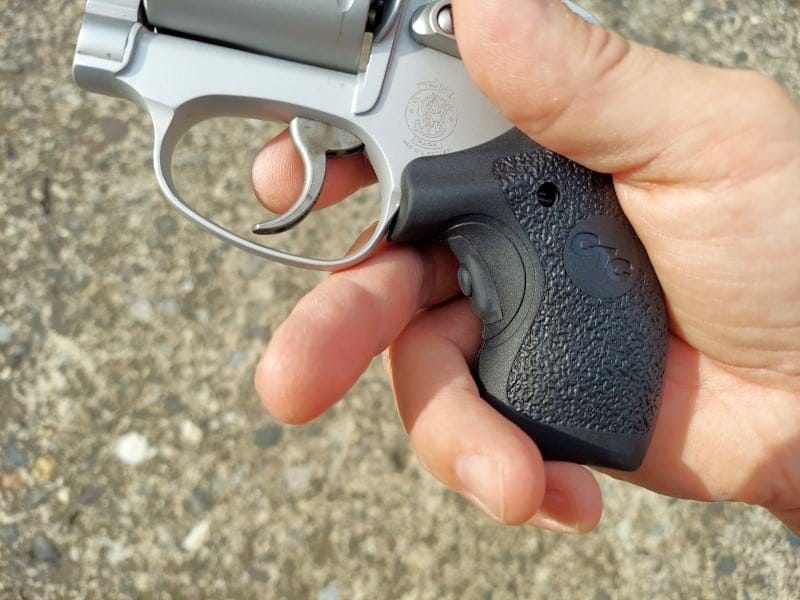
It might be less than good if I don’t want to activate the laser. Let’s say I’m clearing an area. I might not want that laser dot pointing out in front of me as I’m clearing because it could tip off the bad people that I’m up against. In such an instance, I could simply reduce the pressure of my middle finger on the activation button. That, however, would weaken my grip on the pistol.
It’s not a deal-breaker either way, just something to be aware of.
Things To Note
Like most of us, I’ve been trained to keep my trigger finger straight along the frame of the handgun (and rifle, shotgun, etc.) that I’m using unless I’m firing. Doing this might obstruct the laser beam with your finger, as the beam is on the right side of the grip. It’s not a huge deal; you’ll know as soon as it happens and can adjust. Another thing to be aware of.
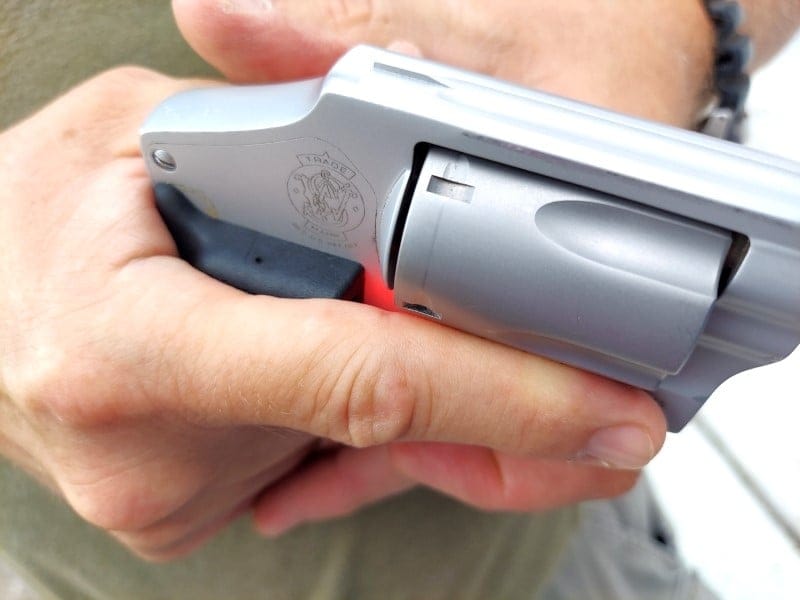
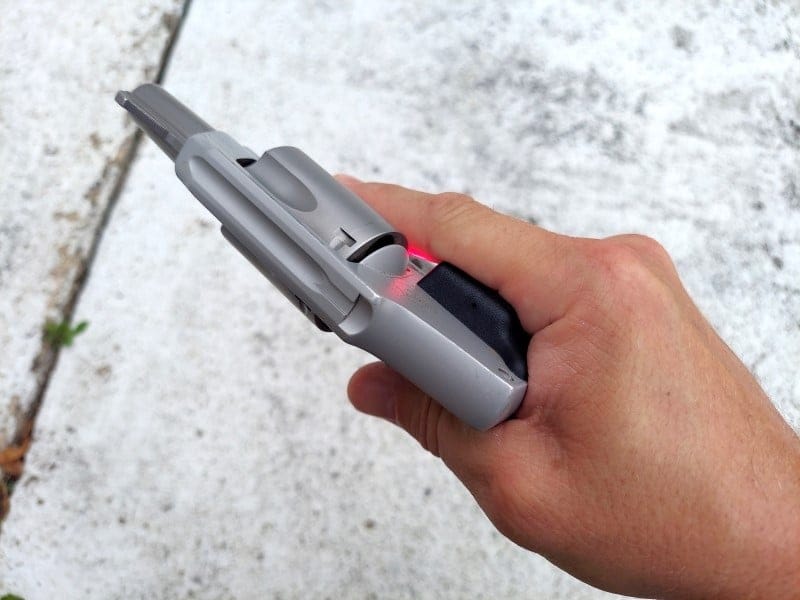
Another interesting thing is using the laser when you dry fire in practice. You can see just how much the trigger pull affects your aim. This is not only good for novices as a teaching tool, but also for seasoned shooters alike.
I will say that it is easier to obtain hits with the laser installed. I always caution people, though. One should not become overly dependent on lasers or other electronics. Being of dinosaur descent, I’ve always been wary of electronics on firearms, since back in the days of the caveman when I was growing up, we had no such things.
Also, be aware that the laser is not a cure-all. It will not illuminate a target in low light, it will only put a dot where you point it. It will not help with positive target identification (PID). Consequently, a handheld white light like the Streamlight Macrostream will be high on your needs list if this is your primary carry gun.
Advantages
- Enhanced aiming in low light.
- Psychological deterrent for threats who might attack. Many are deterred from pressing home their attack.
- Facilitates shooting from awkward positions in which the shooter might have trouble lining up the sights.
- Allows the shooter to fire accurately in conditions where the sights cannot be seen, such as in the dark.
- This design allows the same holster to be used with or without the laser, so no additional holsters need to be purchased.
- The activation button is on the front of the grip, so it comes on automatically.
Disadvantages
- Batteries can die, and electronics can fail.
- Lasers do not illuminate the target in low light.
- The laser signature can give away the shooter’s position.
- Shooters can come to rely on the laser rather than iron sights. It is not a substitute for solid shooting skills.
The Final Verdict
How do I like the Crimson Trace laser grip? So far, I like it. It definitely enhances my accuracy. No, I didn’t measure my groups, as I’m using a .38 Special with a 1 7/8-inch barrel. Torso hits on targets are the order of the day, and speed is the key.
I have to confess that before I installed it, I was skeptical that it would really make much of a difference. Now that it’s been on the revolver for a time, I see that it allows me to get on target faster in low light, and this is even more so when I can’t see the sights well at all. I can bring the revolver up as the laser activates and I don’t have to use the sights, which is far faster in low light conditions.
As mentioned, I wish Crimson Trace could match the grippy, soft texture of the factory grip. If they could do that, I’d be a damn sight happier. Nevertheless, it’s not the end of the world, and their grip does its job well enough.
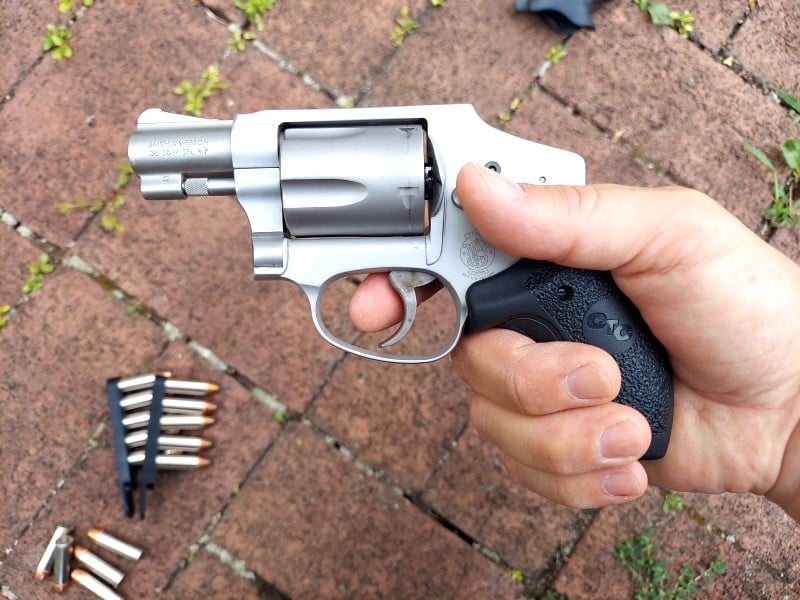
The laser appears to be more than durable enough for the given task, so no complaints there. And it has a three-year warranty, so the user is covered for a good while if there are any issues. Aside from that, this is a well-established, respected company and I’d wager that they’d make any problem good on their end.
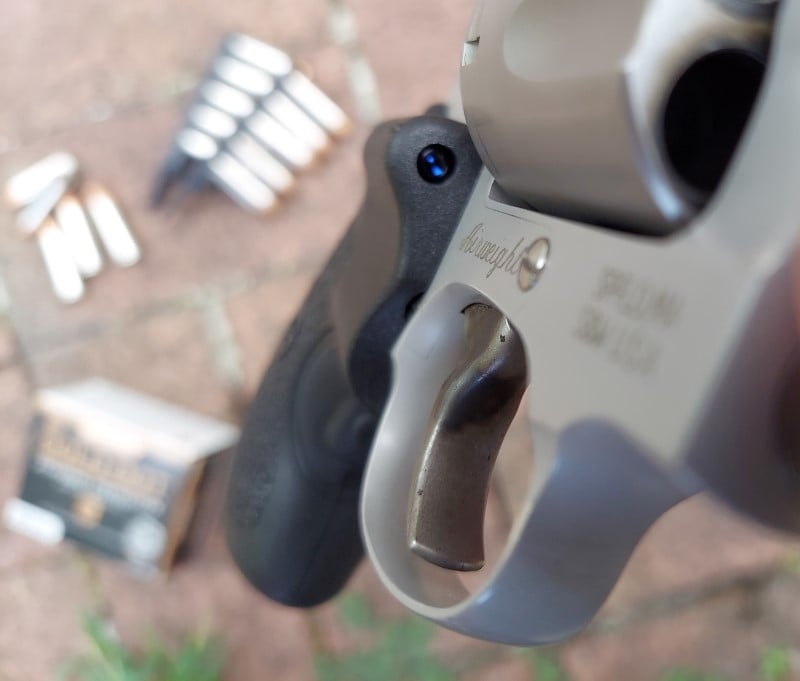
The retail price, at the time of this writing, is $264.99 for the red laser model. It can be found through various distributors for less than that. This is a substantial expenditure (at least, it is for me), so it will take some consideration from shooters as to how badly they want one.
Is it worth it? I’d say yes, given the advantages that it offers. And let’s face it, in an armed confrontation, we want every advantage that we can get. Shaving fractions of a second off the time that we can deliver hits when another person(s) is trying to kill us is certainly worth pursuing.
Also, considering that many confrontations take place in dim light or darkness, this laser is a positive thing. We can’t always see our sights at night, so this can help.
Finally, the psychological factor on the bad guys (when they realize they are painted by a laser and about to be ventilated) is documented to make some people cease hostilities — but that is only a potential advantage. It cannot be counted on, any more than you can assume voice commands, pain compliance, or OC spray will work.
The ability to conclude an incident without violence is golden if we can achieve that. It means we don’t have to deal with the traumatic aftermath of shooting someone, as well as saving money by not having to deal with the court system and lawyers.
Finally, it could save us prison time—because remember, any time we enter the court system, all bets are off as to the outcome.

Yes, I do believe a laser could come in handy under certain circumstances as long as the user factors in the limitations. Why not pick one up and try it out?
Do any readers have experience with laser sights? If so, we’d love to hear your comments! Let us know what you think.


